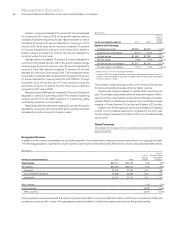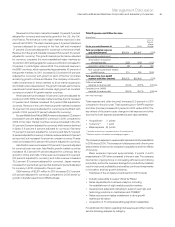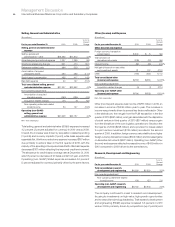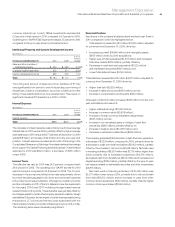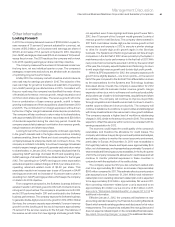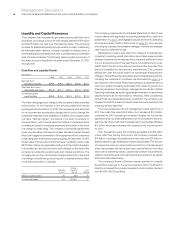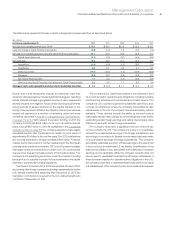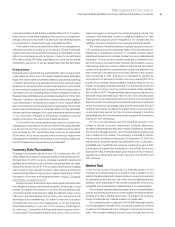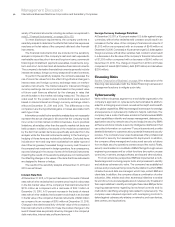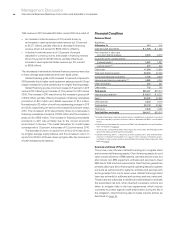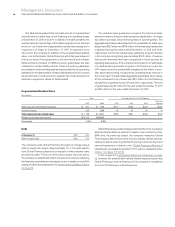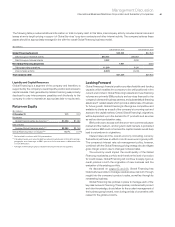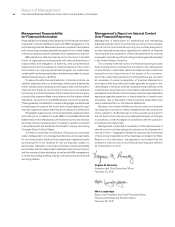IBM 2011 Annual Report Download - page 60
Download and view the complete annual report
Please find page 60 of the 2011 IBM annual report below. You can navigate through the pages in the report by either clicking on the pages listed below, or by using the keyword search tool below to find specific information within the annual report.
58
Management Discussion
International Business Machines Corporation and Subsidiary Companies
Contractual Obligations
($ in millions)
Total Contractual
Payment Stream
Payments Due In
2012 2013-14 2015-16 After 2016
Long-term debt obligations $26,616 $4,292 $ 9,217 $3,185 $ 9,921
Interest on long-term debt obligations 10,585 1,128 1,711 1,362 6,384
Capital (finance) lease obligations 86 19 41 21 5
Operating lease obligations 5,631 1,562 2,324 1,132 613
Purchase obligations 2,207 1,368 586 201 52
Other long-term liabilities
Minimum pension funding (mandated)* 3,900 800 1,500 1,600 —
Executive compensation 1,440 89 194 214 944
Long-term termination benefits 1,374 132 163 141 938
Tax reserves** 3,728 138 — — —
Other 1,250 64 88 86 1,011
To t a l $56,817 $9,592 $15,824 $7,942 $19,868
* Represents future pension contributions that are mandated by local regulations or statute, all associated with non-U.S. qualified defined benefit and multi-employer pension
plans. See note S, “Retirement-Related Benefits,” on pages 121 to 135 for additional information on the non-U.S. plans’ investment strategies and expected contributions and for
information regarding the company’s total underfunded pension plans of $19,232 million at December 31, 2011. As the funded status on the plans will vary, obligations for mandated
minimum pension payments after 2016 could not be reasonably estimated.
**
These amounts represent the liability for unrecognized tax benefits. The company estimates that approximately $138 million of the liability is expected to be settled within the next
12 months. The settlement period for the noncurrent portion of the income tax liability cannot be reasonably estimated as the timing of the payments will depend on the progress
of tax examinations with the various tax authorities; however, it is not expected to be due within the next 12 months.
Total contractual obligations are reported in the table above excluding
the effects of time value and therefore, may not equal the amounts
reported in the Consolidated Statement of Financial Position.
Purchase obligations include all commitments to purchase goods
or services of either a fixed or minimum quantity that meet any of
the following criteria: (1) they are noncancelable, (2) the company
would incur a penalty if the agreement was canceled, or (3) the
company must make specified minimum payments even if it does
not take delivery of the contracted products or services (take-or-pay).
If the obligation to purchase goods or services is noncancelable, the
entire value of the contract is included in the table above. If the
obligation is cancelable, but the company would incur a penalty if
canceled, the dollar amount of the penalty is included as a purchase
obligation. Contracted minimum amounts specified in take-or-pay
contracts are also included in the table as they represent the portion
of each contract that is a firm commitment.
In the ordinary course of business, the company enters into
contracts that specify that the company will purchase all or a portion
of its requirements of a specific product, commodity or service from
a supplier or vendor. These contracts are generally entered into in
order to secure pricing or other negotiated terms. They do not specify
fixed or minimum quantities to be purchased and, therefore, the
company does not consider them to be purchase obligations.
Interest on floating-rate debt obligations is calculated using the
effective interest rate at December 31, 2011, plus the interest rate
spread associated with that debt, if any.
Off-Balance Sheet Arrangements
From time to time, the company may enter into off-balance sheet
arrangements as defined by the SEC Financial Reporting Release
67 (FRR-67), “Disclosure in Management’s Discussion and Analysis
about Off-Balance Sheet Arrangements and Aggregate Con tractual
Obligations.”
At December 31, 2011, the company had no off-balance sheet
arrangements that have, or are reasonably likely to have, a material
current or future effect on financial condition, changes in financial
condition, revenues or expenses, results of operations, liquidity,
capital expenditures or capital resources. See the table above for
the company’s contractual obligations and note M, “Contingencies
and Commitments,” on pages 114 and 115, for detailed information
about the company’s guarantees, financial commitments and
indemnification arrangements. The company does not have retained
interests in assets transferred to unconsolidated entities or other
material off-balance sheet interests or instruments.
Critical Accounting Estimates
The application of GAAP requires the company to make estimates
and assumptions about certain items and future events that directly
affect its reported financial condition. The accounting estimates and
assumptions discussed in this section are those that the company
considers to be the most critical to its financial statements. An
accounting estimate is considered critical if both (a) the nature of
the estimate or assumption is material due to the levels of subjectivity
and judgment involved, and (b) the impact within a reasonable range
of outcomes of the estimate and assumption is material to the
company’s financial condition. Senior management has discussed




